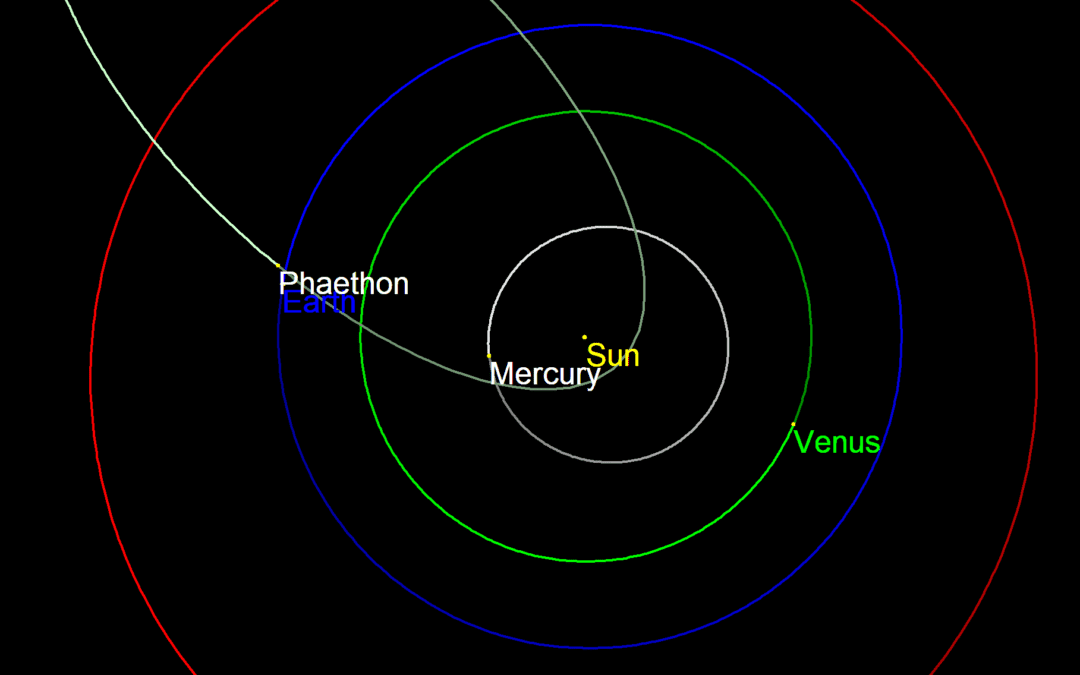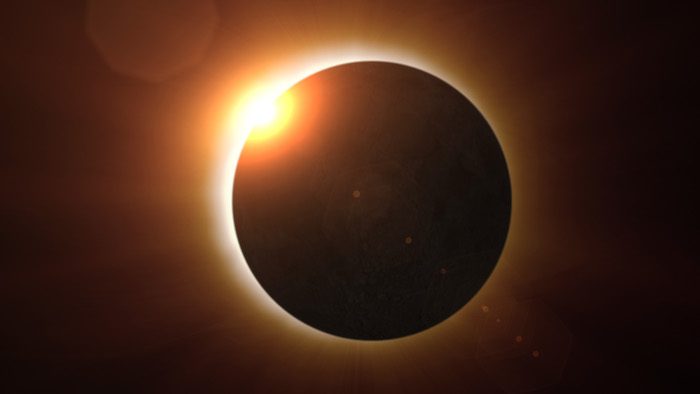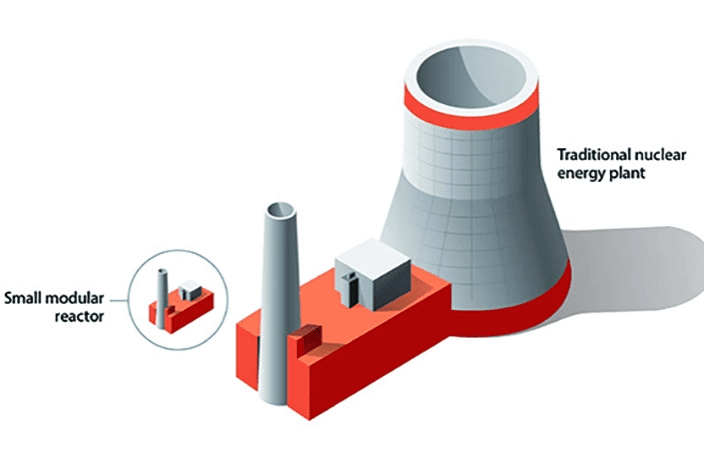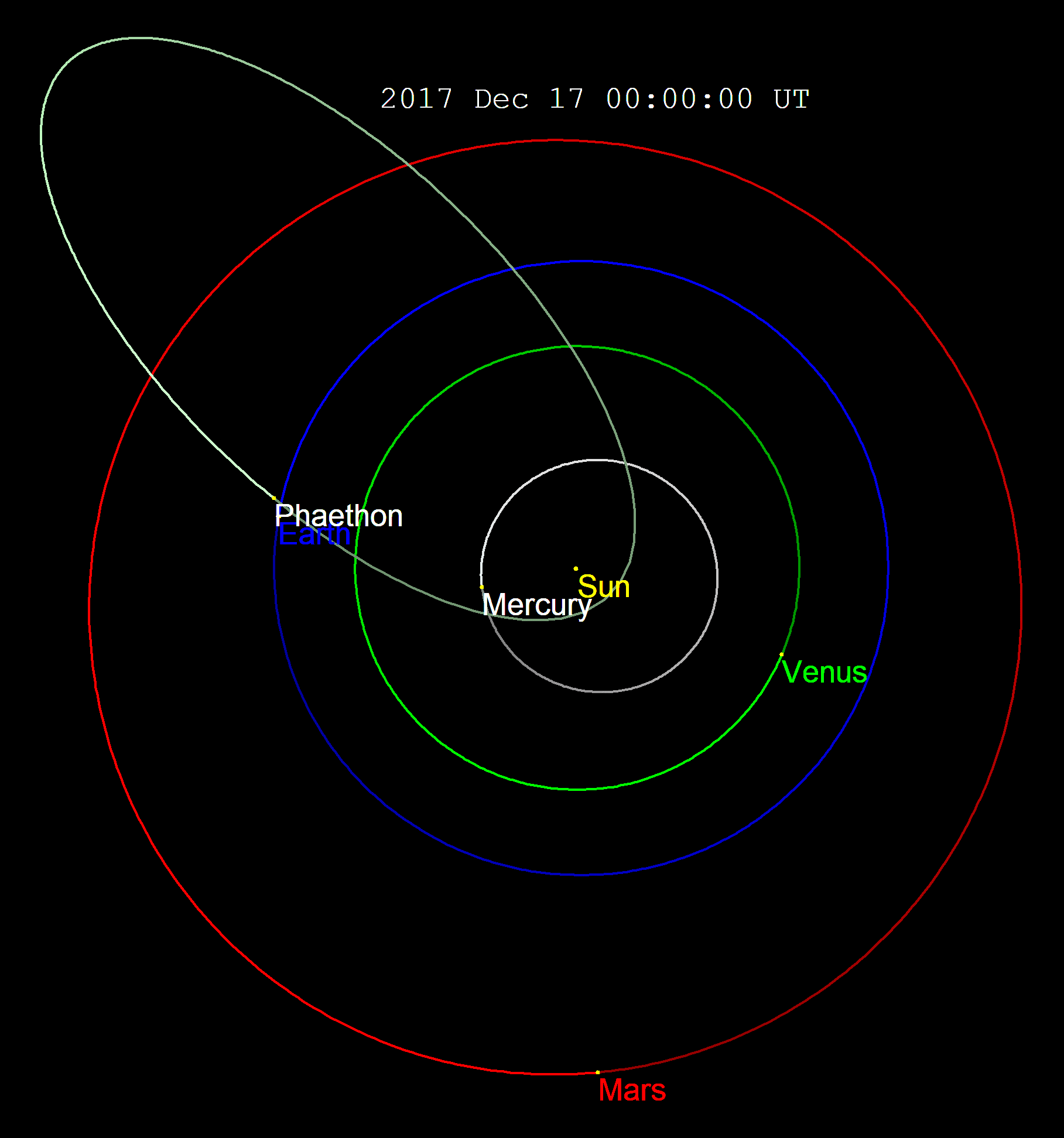
The astroid (light green orbit) passed very close to Earth (blue orbit). Click to enlarge.
On December 16, 2017 at about 5:00 PM CST, the asteroid 3200 Phaethon passed within 64 million miles of Earth. That’s about 27 times the distance to our Moon. While this may sound like a long distance (indeed, it would take on the order of one million hours to drive that distance in a car!), this particular approach will be our closest encounter with the asteroid for another 75 years.
With a diameter of 3.6 miles (about the distance from the Shedd Aquarium to the Lincoln Park Zoo in Chicago), 3200 Phaethon is the second largest asteroid we know of that could present a potential hazard to civilization. In fact, it is not much smaller than the 6 mile diameter asteroid that wiped out the dinosaurs 65 million years ago.
Just last week, an enormous meteor exploded over Chicago with enough force to register a magnitude 2 earthquake. This, plus 3200 Phaethon’s proximity to Earth last month, are stark reminders that hazards within our neighborhood of the Solar System often come dangerously close to Earth.
Because of this threat, we cannot take our existence on this planet for granted. To preserve our safety, it is important to remain consistently vigilant of the threats posed by these asteroids, and to develop plans required to prevent the catastrophic extinctions that have taken place in the past. Thankfully, we have the means to detect and monitor dangerous asteroids in our vicinity, so there’s no need to start looking for the nearest bunker to retreat to for the apocalypse! With advanced warning and international cooperation, it is within our capabilities to save the Earth if it were to be in the path of an asteroid or any other large Near-Earth Object (NEO).
Near Earth Objects
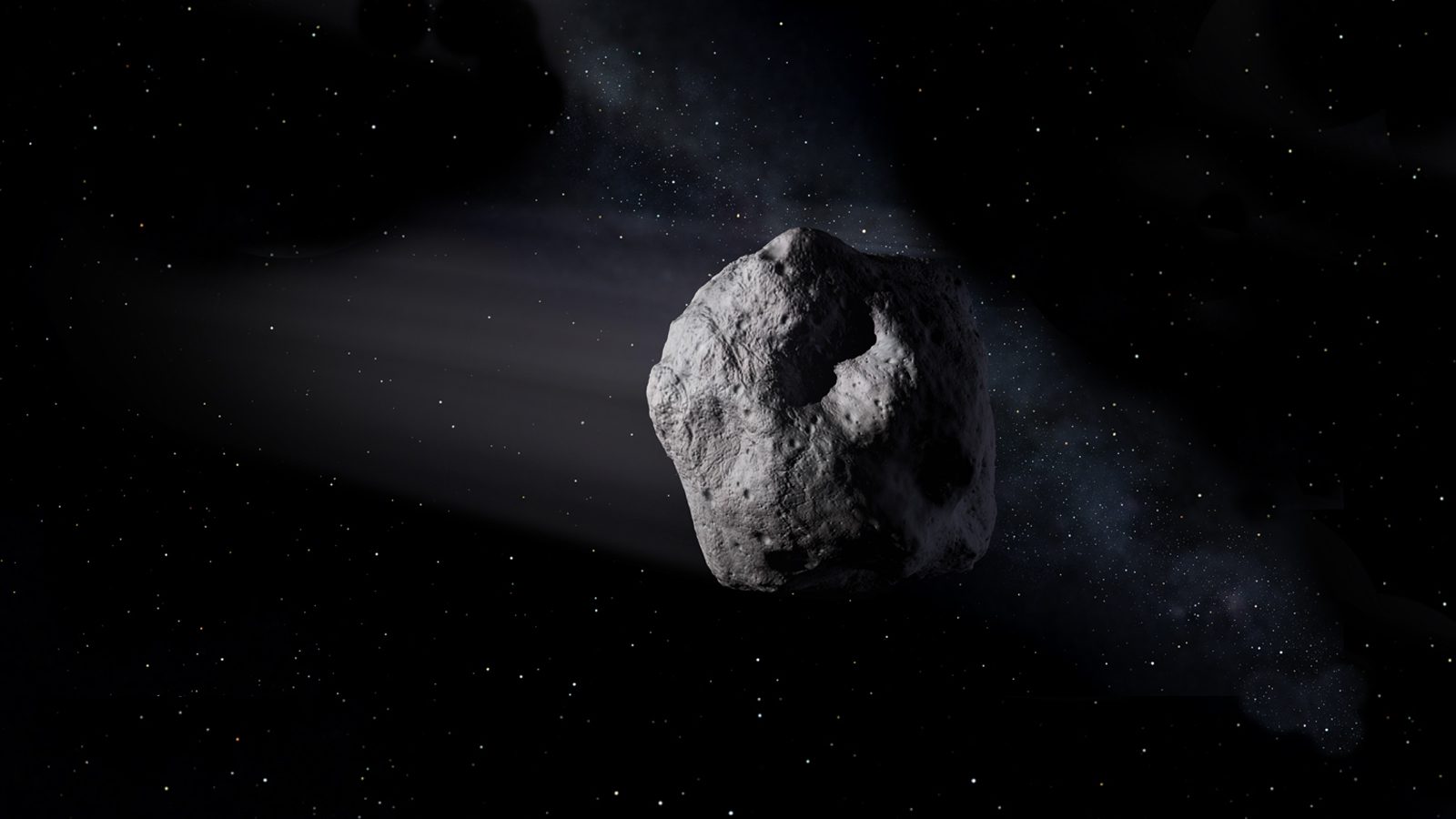
Artist’s concept of a near-Earth object. Image credit: NASA/JPL-Caltech
An NEO is defined as any celestial object (namely asteroids or comets) with orbits that bring them within 1.3 times Earth’s distance from the Sun, or 1.3 astronomical units (AU). NEOs may be deemed potentially hazardous if they are larger than about 140 meters in diameter and if they are predicted to pass within 0.05 AU, or about 20 times the distance to the Moon, of Earth at closest approach. As of December 30, 2017, astronomers have detected 17,546 NEOs, of which 1876 are potentially hazardous. Astronomers detect these hazardous objects using ground-based telescopes as well as observational spacecraft such as the NEOWISE mission. NASA estimates that over 90% of the NEOs in space larger than 1 kilometer in diameter have been detected through programs like this to date.
The Chances of Getting Hit
Near Earth Objects come in all sizes. The probability of impact is inversely related to the size of the object, with small encounters being the most frequent and large catastrophic ones being few and far between. Using geologic evidence and even some historical accounts, we can understand the impact (no pun intended) of these collisions on the global ecosystem and past civilizations, as well as the risk we could expect from future threats.
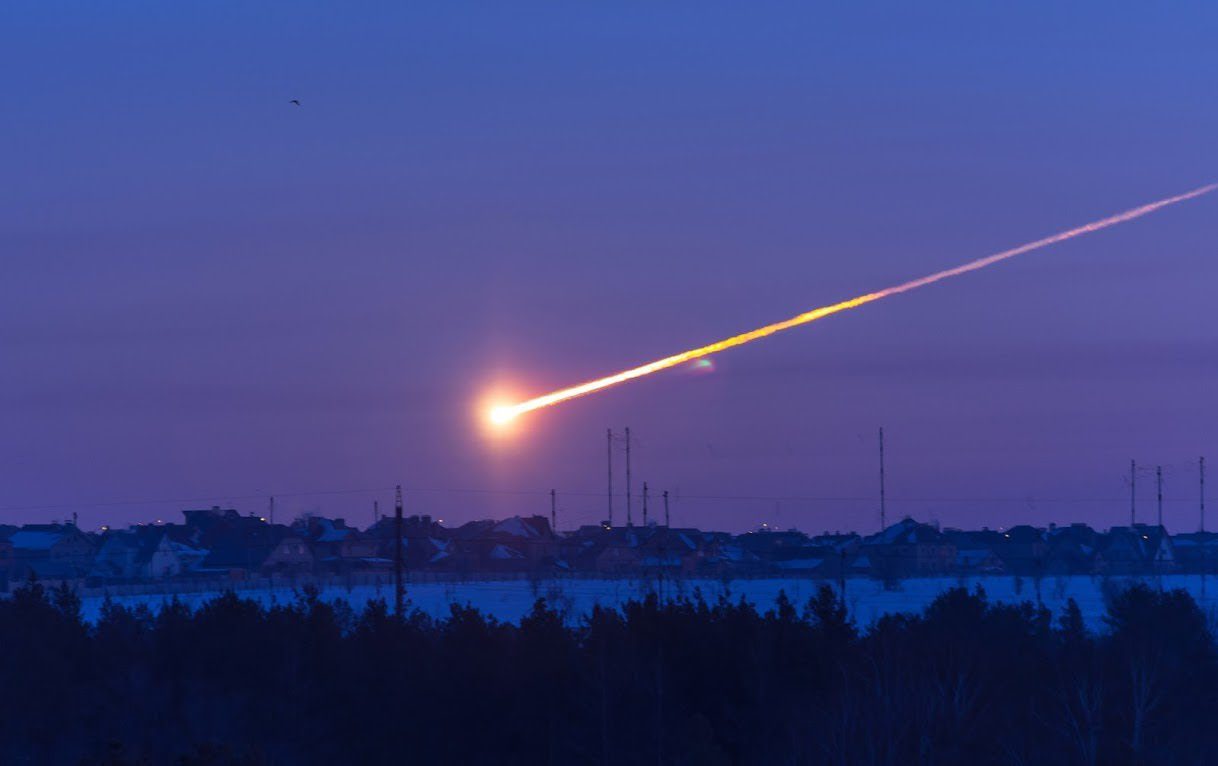
The Chelyabinsk meteor. Click to watch a compilation of videos that captured it as it streaked across the sky.
The smallest NEOs (less than approximately 25 meters across) enter our planet’s atmosphere in tons every day, and they are too small and frequent to detect in advance. Thankfully, most burn up in our atmosphere well before they reach the planet’s surface, leaving no damage. When small objects burn up at night, we can see them as meteors, or shooting stars. The largest meteors, known as fireballs, start as meteoroids the size of cars or larger, and are usually seen about once per year. In 2013, one of these fireballs went viral: the Chelyabinsk meteor that struck without warning in Russia. That meteoroid was about 15-20m in diameter (bigger than a school bus), and was the largest meteoroid to strike our planet in over 100 years. The explosion sent a shockwave powerful enough to shatter windows and knock down structures in the vicinity, injuring approximately 1000 people.
Once every few thousand years, objects between 25m and 1km in size pass through the atmosphere to the surface as meteorites and are capable of causing great damage at a regional scale. Many can leave sizeable impact craters, such as Meteor Crater outside of Flagstaff, Arizona. Such collisions can leave geological evidence, allowing scientists to study the size and composition of the original object. The largest meteoroid to enter the atmosphere in recorded history was the 1908 Tunguska event in Siberia. Although the meteoroid in question disintegrated in the atmosphere without leaving a crater, the resulting explosion created a shock wave that was hundreds of times more powerful than the atomic bombs dropped on Hiroshima and Nagasaki during World War II. As NASA explains, this was powerful enough to completely flatten forests over an 800 square-mile region and cause measurable changes in atmospheric conditions across the entire Eurasian continent!
Objects like 3200 Phaethon, which are larger than a kilometer or two, strike the Earth every few million years, and they produce catastrophic effects at a global scale. Perhaps the most well known is the impact behind the Cretaceous-Tertiary extinction that killed the dinosaurs, as well as the majority of other plant and animal species on the planet at the time. This event was widely discussed in the news in 2016, when drilling samples from the Chicxulub crater on Mexico’s Yucatán peninsula corroborated existing theories for the impact. While these large asteroids would be the most devastating, they are also the easiest to detect. NASA is vigilantly surveying and monitoring NEOs, enabling their detection so we could potentially deflect them before they cause a hazard to life as we know it.

Artist’s reconstruction of Chicxulub crater soon after impact, 66 million years ago. From DETLEV VAN RAVENSWAAY/SCIENCE
Preventing Impact
A number of methods exist to divert the path of an approaching asteroid. For smaller hazards, this could be accomplished by striking the object directly with a high-speed rocket, or by sending a massive spacecraft to slowly tug the object off course using the force of its own gravity. To be effective, such methods require advance notice of a threat, especially for larger asteroids. While firing a projectile into an oncoming threat is the simplest to implement given our current technology, we are still decades away from seeing this as an option that is ready for immediate use. The gravitational tug method remains untested and may take even longer. The time it will take before these options become a reality highlights the importance of proactively monitoring NEOs.
For the largest of asteroids, or as a last resort after failed attempts on smaller options, NASA may have to resort to the nuclear option. This involves attacking the asteroid with a nuclear bomb to produce a massive explosion that deflects its path. This method risks fracturing the asteroid, sending potentially radioactive debris on a collision course with Earth. Nevertheless, this may be a highly effective technique if properly timed. The use of nuclear explosives in space violates the international Outer Space Treaty, however, which was signed in 1967. Bypassing such laws would require cooperation between many nations to avoid conflict.
While these particular options are all technologically feasible, governments have generally invested little in their implementation. As a result, even the most rudimentary of protective measures would require decades of development and preparation to ensure complete reliability when put to use. Because large impact events are sporadic, the proactive detection and monitoring of potentially hazardous objects in our planet’s vicinity is of critical importance for avoiding catastrophe; early warning gives our scientists and engineers the time needed to deflect an asteroid before it’s too late.
Nathan Baskin is a freelance science writer who earned his master’s degree in the Geophysical Sciences from the University of Chicago. You can follow him on Twitter @NathanJBaskin or visit his personal website to learn more about his work.
-
Nathan Baskin is a creative and visual artist originally from Los Angeles, CA, but now based in Chicago.
View all posts

